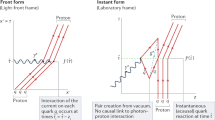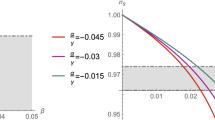Abstract
THE approach of Hoyle and Narlikar1 to quantum electrodynamics provides a good explanation of spontaneous emission, and leads to an expression for the emission rate which is in agreement with the observed rate S, provided that the zero-point oscillations of the electrodynamic field are ignored. Previously it was considered2 that spontaneous emission was induced by these oscillations but, because there is only an energy of ½hν per state, the predicted rate in this case is only ½S.
This is a preview of subscription content, access via your institution
Access options
Subscribe to this journal
Receive 51 print issues and online access
$199.00 per year
only $3.90 per issue
Buy this article
- Purchase on Springer Link
- Instant access to full article PDF
Prices may be subject to local taxes which are calculated during checkout
Similar content being viewed by others
References
Hoyle, F., and Narlikar, J., Nature, 219, 340 (1968).
Schiff, L., Quantum Mechanics, 400 (McGraw-Hill, 1955).
Wheeler, J., and Feynman, R., Rev. Mod. Phys., 17, 157 (1945).
Bondi, H., Cosmology, 60 (Cambridge University Press, 1960).
Author information
Authors and Affiliations
Rights and permissions
About this article
Cite this article
PEGG, D. Cosmology and Electrodynamics. Nature 220, 154–155 (1968). https://doi.org/10.1038/220154a0
Received:
Issue Date:
DOI: https://doi.org/10.1038/220154a0
This article is cited by
-
Time-symmetric Electrodynamics and Self Action
Nature (1969)
-
Cosmology and Electrodynamics
Nature (1968)
Comments
By submitting a comment you agree to abide by our Terms and Community Guidelines. If you find something abusive or that does not comply with our terms or guidelines please flag it as inappropriate.



